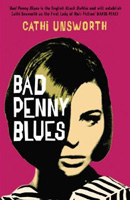

Serpent's Tail, paperback, 978184668788
Quite frankly, my first reaction upon reading the blurb on the back of the book had me wondering. I was expecting a bit of hardboiled crime (the word "noir" is plastered all over the cover), yet here was the curious sentence:
Meanwhile Stella, a young fashion designer, is woken by terrifying nightmares that echo the last hours of the dead women.
Was this really an occult novel? The answer was largely moot—twenty pages in I was quite engrossed in the story, not caring about its genre. To answer the question, however: while there is an element of Spiritualism woven through the story, this is definitely crime fiction of the noir variety.
Unsworth builds her story around the Jack the Stripper murders of the mid-1960s. These crimes remain unsolved and occasioned the biggest manhunt ever done by the Greater London Metropolitan Police. The novel covers six years, alternating chapters between Peter Bradley, the constable who finds one of the early bodies and can't let it go, and Stella Reade, a young, newly-married art student whose immersion and rise in the hip world of London's art and fashion scene is marred by periodic horrifying nightmares.
Though these two story lines connect only marginally from the characters' points of view, the relationship is clear to the reader from the beginning, and their different perspectives impart a depth to the story that neither could achieve alone. On one hand, Peter's story is the public frenzy: the tabloids screaming their exposés, the mob's fascination that gives everything a pornographic cast. Stella's viewpoint shows the reader the horror that is the underlying reality: the fear felt by the working girls as they moved through their lives, the terror in the victims' minds as they realized that, despite their precautions, they were about to die.
The novel also has a third main character: London of the early '60s. Popular retrospection has imparted a bit of a mod or slick aura to it but, in true noir fashion, Unsworth turns over the surface to show the dark underbelly. She suffuses the story with a dark misogyny, even beyond the sickness of the murders. She portrays a casual and automatic racism on the part of any who hold power and many who do not. She reveals the corruption that pervades the government and the police.
Beyond her vivid depictions, Unsworth draws you into that time and that place through her choice of titles for sections and chapters, each of which is a song. I emailed her, asking about the relevance and, in addition to telling me that "'Bad Penny Blues' would make the best theme to a crime movie ever," each title is a hit from charts of that chapter's instant in history. In those moments when victims are found, it is the #1 hit from that particular day. This is extremely effective; once you recognize this hook, you can't stop associations from being triggered—"I Saw Her Standing There" conjures the coming Beatlemania while "Distant Drums" evokes the growing Viet Nam controversy.
The result is a very engrossing crime novel in true noir fashion, full of unsentimental violence and anger, populated
with fleshed out characters—some her creation, some thinly-disguised personalities of the day—and leavened
by the occasional flash of humor. I look forward to her next book.
